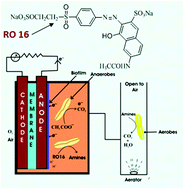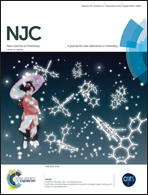Bio-electro degradation of azo-dye in a combined anaerobic–aerobic process along with energy recovery†
Abstract
A combined anaerobic–aerobic process involving a single chambered microbial fuel cell (SMFC) followed by an aerobic downstream treatment process is selected for the complete removal of reactive orange 16 (RO 16) from contaminated water. The degradation of azo-dye in SMFC results in the formation of aromatic amines with simultaneous production of electricity. The degradation products of the SMFC were further treated in an activated sludge downstream process in order to provide complete solution from dye wastewater. More than 90% of the chemical oxygen demand (COD) was removed in the combined process for all the test concentrations. The maximum output cell potential and the coulombic efficiency (CE) were 423 mV and 3.4% respectively. SEM images of the mixed microbial culture showed the presence of cocci, diatoms and rod shaped bacteria. Cyclic voltammetry revealed that a perfect redox process took place in the SMFC system. The results of the gas chromatography coupled with the mass spectroscopy (GC/MS) technique showed that RO 16 was first converted into aromatic amines in SMFC which were further transformed into phthalic acid and finally into benzoic acid. The results of the present work demonstrate that wastewater containing complex and toxic dyes can be successfully treated in SMFC followed by aerobic post-treatment along with energy recovery.


 Please wait while we load your content...
Please wait while we load your content...